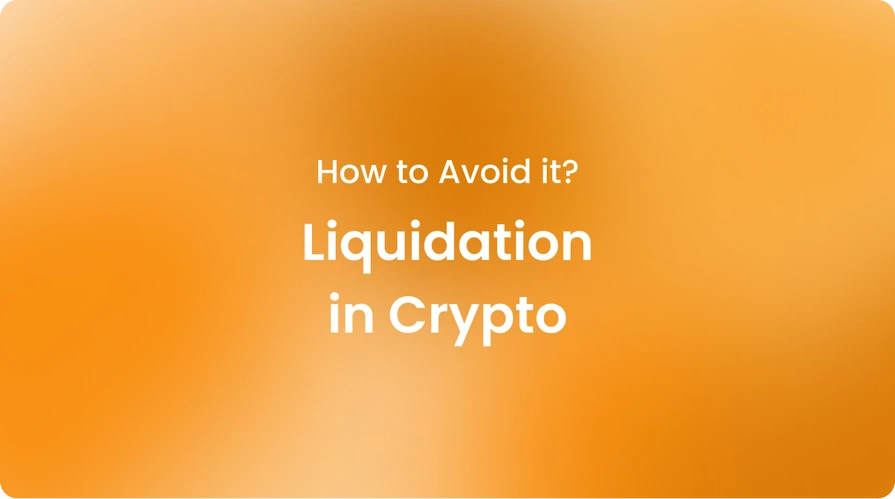|crypto, knowledgehub
What Is Liquidation in Crypto? How to Avoid It?

Many blockchain terms, such as liquidation in crypto, have entered our lives in recent years with the digitalization of the age and the development of technology. The currencies used on digital platforms have taken the place of previous investment types.
Millions of people use cryptocurrencies, which are investment tools that emerged as a result of digital developments and global interaction. Apart from investment, cryptocurrencies are needed for simple everyday transactions such as e-commerce payments.
The use of so many types of cryptocurrencies brings along some detailed concepts. One of the concepts we have heard frequently in recent years is crypto liquidation. It is the name given to the forced closure of a transaction or position in a purchase or sale transaction.
Margin exhaustion is a result of the need to close the transaction. The concept that seems a bit complicated will actually be more understandable as we go into detail.
Join us in this blog as we analyze crypto liquidation in detail with the concept of margin trading for you. Therefore, you will have a much more comprehensive understanding of this subject by the end of this guide. Let’s start with exploring margin trading to better understand liquidation in crypto!
What is margin trading?
Details such as margin trading are one of the most frequently wondered concepts in cryptocurrencies. In summary, the concept describes the utilization of third-party assets. It is the possibility of earning a high income by using the resources provided by a third party.
The aim here is to help you reach more principals. Therefore, it is preferred to provide leveraged use in positions. With simple logic, leverage in the forex system can be an example. However, it would not be wrong to say that it has more different and differentiating points.
It is the formation that allows individuals to make more profit in successful transactions. Margin trading acts like a debt purchase under leverage. For example, for an investment of 200 thousand dollars with 10:1 leverage, a principal capital and collateral of 20 thousand dollars will be required.
One of the biggest advantages is a high profit return. Since it is a collateralized and leveraged system, it is traded with a higher principal. The disadvantage is that the increase in the profit rate has the same effect in negative situations.
Therefore, it would not be wrong to say that there is a high risk of loss. We recommend that you work with a reliable digital bank in this regard. You can get help from specialized institutions such as Cryptobunq.
At what margin level do you get liquidated?
When the margin level reaches a certain level, the transaction is closed automatically. Therefore, since it acts as an indicator, it is found according to certain calculations. It is possible to find it by calculating net profit share / margin x 100%.
For example, if an investor does not have any open transactions, it will be seen that the margin level is zero. After the position is opened, the process is shaped according to the amount of volume, market type, and leverage.
Generally, in cryptocurrency transactions made by quality brokerage houses, the margin level is determined and displayed by itself. Therefore, you should carefully choose the institution and digital bank you trade with. In this regard, you can trust Cryptobunq, as it is an expert crypto service provider.
What is an example of crypto liquidation?
We can use an investment with collateral as an illustration of crypto liquidation. In a transaction with margin trading, the person needs to collateralize $10,000 in principal in order to have a capital of $100,000. Since we consider that there is a 1 in 10 leverage system, the principal will be in this way.
The person's investment progresses negatively and incurs losses along the way. Therefore, as a result of the excessive increase in the loss, it is possible to terminate the debt and all remaining assets. Thanks to crypto liquidation, the transaction is forcibly closed, so the investor raises the flag of bankruptcy.
What causes liquidation in crypto?
Liquidation in crypto reasons is one of the main issues that people are curious about. The most important factor here is related to the use of the leveraged system during crypto investment. While the profit is much higher with the use of leverage, the loss is also high in negative situations.
We can think of this situation as borrowing money. It is seen that a person who bets by borrowing money will earn high profits if he or she wins. However, in the event of a loss, he or she will experience a loss of income as he or she will be in debt.
Since margin trading involves the use of collateral and leverage, in cases of large losses, the transaction needs to close itself compulsorily.
What is the liquidation process for cryptocurrency?
In the crypto liquidation process, transactions are closed automatically for certain reasons. It is a situation where the position is closed compulsorily in buying and selling. The transaction is compulsorily closed as a result of margin exhaustion or the achievement of the maximum margin.
It is important to work with a secure digital bank or financial company to manage your crypto transactions more securely. The digital institution that offers you the best service in this regard is a global crypto-friendly digital bank, Cryptobunq.
What is the difference between long liquidation and short liquidation?
Liquidation appears in two different categories: long and short liquidation. Therefore, the differences between long and short are one of the main issues people wonder about. We would like you to have more comprehensive information about the subject by explaining the main differences between the two.
As the name suggests, short liquidation transactions cover liquidations made according to price increases. Therefore, it corresponds to mandatory transaction closure situations in short position types.
In long liquidation transactions, it corresponds to mandatory closures or liquidations in futures transactions and long positions. Therefore, these are situations that vary according to the type of transaction and leverage system.
Key steps to minimize the crypto liquidation
Liquidation in crypto transactions can change the leverage ratio to go down to minimum levels. In addition, keeping the risk share and profit amount lower is one of the acceptable precautions.
You can also absorb the amount of liquidity and keep it at minimum levels with the advantages provided by the cryptocurrency exchange or digital banks you work with. Cryptobunq is one of the institutions that provides the best service in this regard.
As a one-stop shop crypto service provider, CBQ offers a wide range of blockchain-powered services such as custody and wallet, checkout and invoicing, exchange API, tokenization, node services, batch payments, and more.
You can trust CBQ to invest in crypto and secure your crypto assets without facing liquidation risks. Fast, secure, and easy transactions are possible with CBQ. If you want to benefit from our expert services, contact us!













